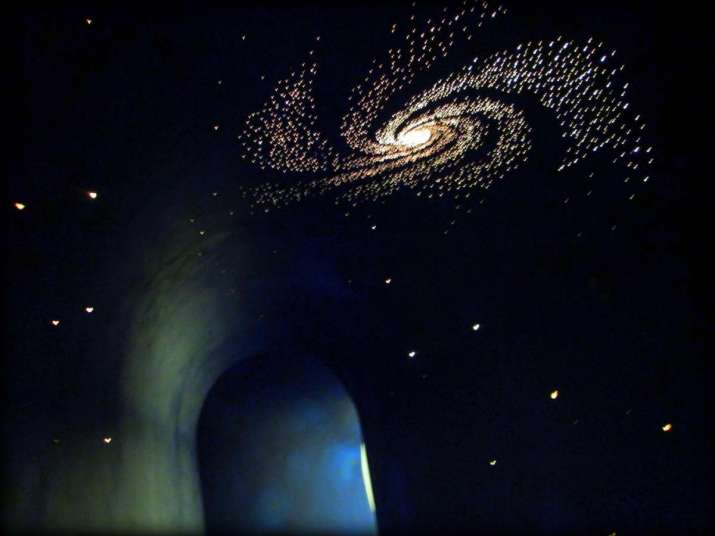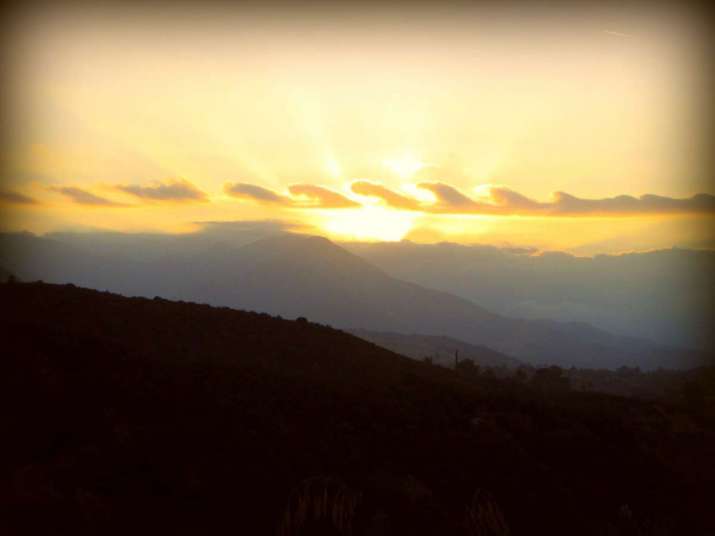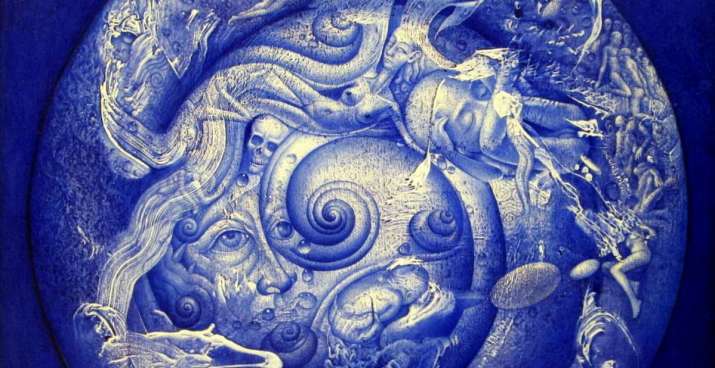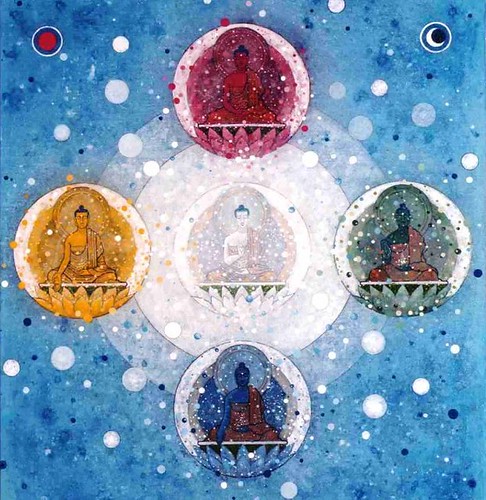FEATURES|COLUMNS|Creativity and Contemplation
Bringing Awareness Practice from Retreat into the World
 Dreamscape, Bangkok © 2015 Sarah C. Beasley
Dreamscape, Bangkok © 2015 Sarah C. BeasleyMany Buddhists spend at least part of their time practicing in a retreat setting, cultivating the qualities so needed to survive and thrive in today’s world by building capacity for themselves and others. Vajrayana teachings speak of two levels of experience: the relative and the ultimate. In this human form, we are always engaged on the relative level, which is interconnected with the ultimate. Whether approaching formal deity visualization practice or enacting formless meditation, we engage the process of awakening.
I like to think of it as falling into awareness. This is the opposite of falling asleep, or remaining in ignorance. On the ultimate level, we have never strayed from our primordially pure true nature. It’s just that we forget, and meditation practice is the tool for reconnecting. Taking time for retreat can be an effective way to recognize old habits and cultivate a growing intimacy with awareness and more skillful means of relating with ourselves and society.
In the closed retreat setting, there are three levels of containment. There is the outer container of the retreat environment, the boundary of the physical place and supports. There is the inner container of our intention and commitment to approach meditation practice in order to create benefit, and finally the secret container of the innermost heart’s desire to realize our true nature. During a recent group retreat, I noticed six aspects of the environment that support the practice of going deeper beneath our usual habitual tendencies and emotional patterns. To share a page from my retreat notebook:
In silence, awareness of the Pureland is that much greater.
Each sangha member mirrors a facet of my (nonexistent) self.
The elements arise and subside and abide as supports for gentle awakening.
Creatures appear and disappear, stoking recognition of the movement of hopes and fears.
Emotions emerge and dissolve like clouds, dissipating if not reinforced with rumination.
Great sky-space embraces all, and limitless empty wisdom-compassion is expressed as the guru’s timeless love.
 Sunset in the Pureland, Ojai CA © 2015 Sarah C. Beasley
Sunset in the Pureland, Ojai CA © 2015 Sarah C. BeasleyThis isn’t to imply that all is bliss and rainbows in retreat practice! These feeling-insights came after multiple days of upheaval and wrestling with recurrent karmic patterns of mind, swirling as emotion, memory, and disturbing dreams. The longer a retreat lasts, the more time and space can open to unravel knots in the mind, body, and energy field. Extended silence can be an underrated aspect of practice in retreat, whether group or solo. Without conversation to distract, the ordinary mind quiets down enough to reveal subtler layers of subconscious thought, including replaying the past and imagining the future.
Dreamtime practice, or dream yoga, can also be invaluable and a great use of time for awareness practice. Once, the lama appeared to me in a dream, saying, “The emotions are just another opportunity to see our true nature, deeply.” Then each of us students climbed into giant washing machines! Dream imagery is a compelling tool for cutting through conceptual thought. In the group session we had been exploring the mandala of the five elements, five dakinis, five buddha families, colors, senses, and the five wisdoms that arise from each of the five afflictive emotions. These potent Vajrayana symbols enable the practitioner to embody, in both waking and dreaming states, the modes of transformation and liberation of repetitive habits that plague us through countless lifetimes.
When we practice any kind of meditation, whether on the cushion, walking, in a dojo, or a yoga class, simply by pausing in time we access timeless awareness. Cultivating this over time leads to a strengthening of our meditative muscles. But what about life in action, upon our return to society? These challenging times call us to practice at home, at work, in the streets, in the political arena, whether with friends, family, strangers, or colleagues.
In ordinary conversation or in active conflict, opportunities arise to immediately draw on our grounding, the basis of wisdom and compassion in action. Staying rooted in remembering our true nature, beyond the temporal personality, gives us a place from which to act with awareness, as opposed to being reactionary. As meditation graduates from the cushion to the sidewalk, we integrate wisdom-compassion in our everyday world, and find strength and patience for more difficult encounters. Alternating periods of short or longer retreat with life in the world can shore up our meditative stability.
It has been said of Zen Master Thich Nhat Hanh that, “It is impossible to distinguish between his social work and his enlightenment work.”* Our planet is bursting with conflict, whether in Syria, Tibet, Nigeria, Turkey, North Dakota, or in US politics, our workplace, our neighborhoods, or at home. We need both formal and informal practice to be of maximum benefit in all settings, especially when the going gets rough.
 The World, detail, Bangkok © 2009 Thongchai Srisukprasert
The World, detail, Bangkok © 2009 Thongchai SrisukprasertWhere there are human beings, there is suffering. Humans suffer from “I-me-mine-itis,” a corrupt self-absorption based on hope and fear. One antidote is looking with active compassion toward the many in less fortunate circumstances than ourselves. A crucial response to the pervasive hate, fear, and ultraviolence of our times is vaster love, deeper tolerance, and firmer commitment to help end suffering.
Embodying, expressing, and enacting relative and ultimate bodhicitta (the genuine heart of awakening) through prayer and action, we can earnestly pray and work for the good of others; all others. From Martin Luther King, Jr., Mother Teresa, and the Dalai Lama, to Nelson Mandela, Pope Francis, Mahatma Gandhi, and so many others, the great spiritual leaders of our times have always engaged in peaceful protest, meditation, and prayer, speaking out tirelessly, putting their lives on the line to bring justice to the oppressed. I imagine that they, too, needed times of quiet and introspection to renew themselves before facing the suffering world once more.
“Meditation is simply the final stage of embodiment. Through the three prajnas of hearing, contemplating, and meditating, we ingest, digest, and metabolize the Dharma. We embody it. And now that we have a nourished body [and speech and mind], we use it.”** We use our whole being to benefit others. Retreat, whether for three days, three months, or three years, is a powerful way to invigorate our awareness practice, our compassion reserves, and motivation to benefit others on both the relative and ultimate levels. Even three minutes of calming one’s mind is invaluable as a reset. Re-entering the world after retreat is how we integrate these experiences and test our newfound insight, patience, and generosity of spirit.
Here and now, the future of our very planet is at stake, not only humanity and countless other species. Time is too short to merely pray, while relying on action alone we may forget the ground of wisdom. As Guru Rinpoche himself said: “Though my view is as high as the sky, my discernment of correct conduct is as fine as barley flour.” May we tirelessly call upon the wisdom and compassion of the great teachers of all traditions to realize our timeless true nature, and to help end the suffering of countless beings through heartful prayer, selfless generosity, and intelligent action. May our cultivation of awareness of the true nature of reality ever deepen and refine. May all those who wish to engage in authentic practice in retreat find the auspicious circumstances in which to do so.
* Peace is Every Step (YouTube)
** The Value Of Three-Year Retreat (Andrew Holecek)
A Vajrayana Buddhist practitioner since 2000, Sarah C. Beasley (Sera Kunzang Lhamo) spent more than six years in retreat under the guidance of Lama Tharchin Rinpoche and Thinley Norbu Rinpoche. She is an experienced teacher, writer, sculptor, photographer, dancer, and Iyengar yoga practitioner. Sarah offers a workshop, “Meditations for Death, Dying & Living,” based on the text Vajrasattva Ceremony for the Dead (Concise Nay Dren). For more information, visit Moondrop.
Related features from Buddhistdoor Global
Loving your Tick: Book Review of Mindfulness as Medicine
Master Shandao’s Exegesis on the Deep Mind: Gain and Loss in the Two Kinds of Practices
100-day Mahamudra Transmission at Palpung Sherabling: The Silent and Far Reaching Call of the Ultimate
















